Native to Russia, Japan Native speakers 200 (2010 census) | Ethnicity Nivkh | |
 | ||
Pronunciation [mer ɲivx dif/tuɣs] (Amur dialect);
[ɲiɣvŋ duf] (S.E. Sakhalin dialect) Region Sakhalin Island, and along the Amur River Language family Language isolate, but included in the group of Paleosiberian languages for classification convenience | ||
The nivkh language and the ainu language part 1
Nivkh or Gilyak /ˈɡɪljæk/ (self-designation: Нивхгу диф Nivkhgu dif) is a language spoken in Outer Manchuria, in the basin of the Amgun (a tributary of the Amur), along the lower reaches of the Amur itself, and on the northern half of Sakhalin. "Gilyak" is the Manchu appellation. Its speakers are known as the Nivkh people.
Contents
- The nivkh language and the ainu language part 1
- Classification
- History
- Dialects
- Grammar
- Consonants
- Vowels
- Stress
- References
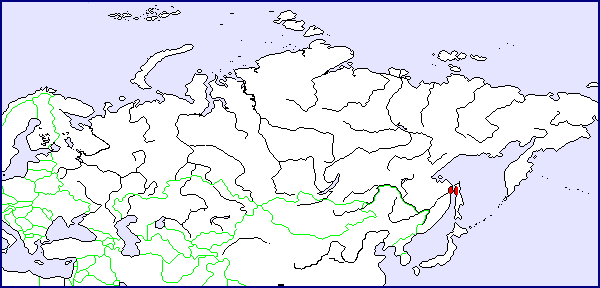
The population of ethnic Nivkhs has been reasonably stable over the past century, with 4,549 Nivkhs counted in 1897, and 4,673 in 1989. However, the number of native speakers of the Nivkh language among these has dropped from 100% to 23.3% in the same period, so that there are now just over 1,000 first-language speakers left.
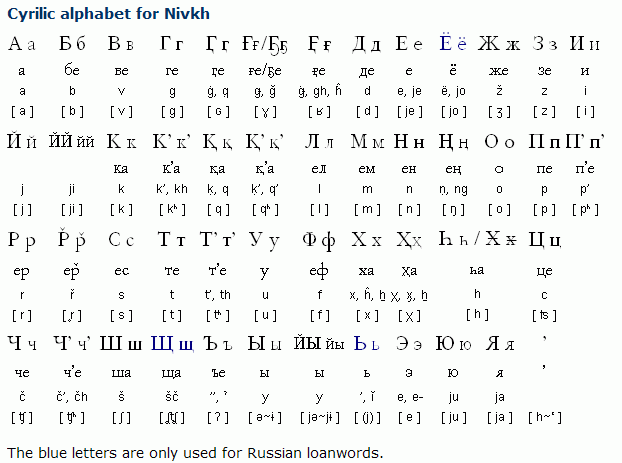
Classification
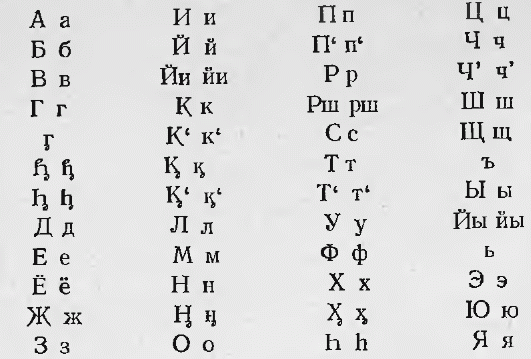
Nivkh is not known to be related to any other language, making it a language isolate. For classification convenience, it is included in the group of Paleosiberian languages. Many words in the Nivkh language bear a certain resemblance to words of similar meaning in other Paleosiberian languages, Ainu, Korean, or Tungusic languages, but no regular sound correspondences have been discovered to systematically account for the vocabularies of these various languages, so any lexical similarities are considered to be due to chance or to borrowing.

The Nivkh language is included in the controversial Eurasiatic languages hypothesis by Joseph Greenberg. Michael Fortescue has suggested in 1998 that Nivkh may be related to the Mosan languages, and later, in 2011, he has argued that Nivkh, which he also refers to as an "isolated Amuric language", is related to the Chukotko-Kamchatkan languages, forming a Chukotko-Kamchatkan-Amuric language family. More recently, Sergei Nikolaev has argued in two papers for a systematic relationship between Nivkh and the Algic languages of North America and a secondary relationship between these two together and the Wakashan languages of coastal British Columbia,.
History
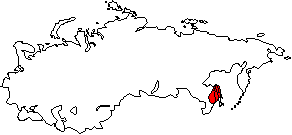
The Nivkh people have lived, by many accounts for thousands of years, on the island of Sakhalin and the Amur River. They maintained trade with the neighboring Ainu, Japanese, and Chinese, until Russian contact, which began in the 17th century. The 19th century shows the first recorded decline of Nivkh numbers, with official estimates dropping from 1856 to 1889. This coincided with smallpox epidemics and the expansion of Sakhalin's prisoner population, as Russia began sending groups of its convicts to Sakhalin in 1873. At this time, reportedly few Nivkh spoke Russian.
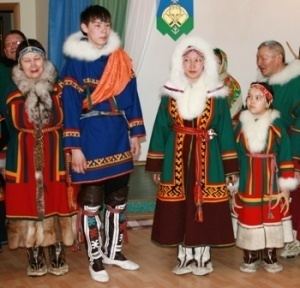
Revolutionary and post-revolutionary Russia accorded large changes for the Nivkh. The 1920s ushered in years of guerilla fighting in the area, Russians against Japanese, ending in 1925, when Japan ceded Sakhalin to the Soviets. The violence lead to Nivkh deaths, as the area's resources were depleted and disease spread. Later, Stalin's policy of collectivization was imposed on indigenous economies, and in many cases, drove Nivkh individuals to hired labor, marking a departure from traditional means of subsistence. Many Nivkh were forcibly displaced from their more widely spread settlements to Nogliki, a small city, in the process of centralization. The traditional Nivkh way of life was gradually and sometimes forcibly converted to a Soviet way of life, as changes in subsistence, diet, dwellings, and education have resulted.
Dialects
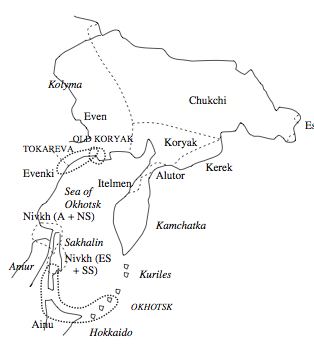
Nivkh is divided into four dialects, the Amur dialect, the North Sakhalin dialect, the South Sakhalin dialect, and the East Sakhalin dialect. The lexical and phonological differences between the dialect spoken by the Nivkhs of the Amur River basin and the dialect spoken by the Nivkhs of Sakhalin Island are so great that some linguists have classified them as two distinct languages belonging to a small Nivkh language family. Other linguists have emphasized the high degree of variability of usage among all Nivkhs; even within the Amur or Sakhalin dialect zone, there is said to be great diversity depending on the village, clan, or even individual speaker.
Grammar
Nivkh is an agglutinating synthetic language. It has a developed case system, as well as other grammatical markers, but no grammatical gender. The basic word order of Nivkh is subject–object–verb, the subject being frequently omitted in speech.[9] Nivkh is notable for the high degree of incorporation between words. For example, those morphemes which express spatial relationships (prepositions or postpositions in many other languages) are incorporated into the noun to which they relate. Words consist of easily definable roots and productive grammatical morphemes, most of which are suffixes. Nivkh has no adjectives, but rather verbs that describe a state of being. There are two verb tenses: non-future and future. The non-future form may combine with adverbials, as well as context, to indicate a time frame.
As Russian has become the dominant language in all spheres of life, Nivkh grammar has changed in the last century. For example, Nivkh has recently begun to mark plurals on counting nouns and pairs, a change that originated from the grammar rules of Russian. However, it has been postulated that due to the vastly differing grammatical structures of the two tongues, grammatical interference has not been extensive. Simplification has occurred past borrowed Russian structure, though; due to disuse of the language and a changing culture, many of the complex morphological aspects of Nivkh have been simplified or fallen out of use. In a process referred to as obsolescence, things like the distinction between the morpheme for counting sledges and the morpheme for counting fishnets have disappeared, with speakers opting to use more general categories of counting numbers or other descriptors.
Consonants
The labial fricatives are weakly articulated, and have been described as both bilabial [ɸ, β] and labiodental [f, v]. The palatal stops may have some degree of affrication, as [tʃʰ, tʃ]
Nivkh's phonemic distinction between velar and uvular fricatives ([ɣ] vs. [ʁ] and [x] vs. [χ]) is rare among the world’s languages. These sounds do occur in a great deal of languages, but usually they are interchangeable.
Nivkh features a process of consonant alternation, in which morpheme-initial stops alternate with fricatives and trills:
This occurs when a morpheme is preceded by another morpheme within the same phrase (e.g. a prefix or an adjunct), unless the preceding morpheme ends itself in a fricative or trill, or in a nasal or /l/.
Only the morpheme-initial position is affected: other clusters ending in a stop are possible within a morpheme (e.g. /utku/ "man").
In some transitive verbs, the process has been noted to apparently run in reverse (fricatives/trills fortiting to stops, with the same distribution). This has been taken a distinct process, but has also been explained to be fundamentally the same, with the citation form of these verbs containing an underlying stop, lenited due to the presence of a former i- prefix (which still survives in the citation form of other verbs, where it causes regular consonant alternation). Initial fricatives in nouns never change.
After nasals or /l/, the unaspirated stops become voiced [b, d, ɟ, ɡ, ɢ]. Unlike consonant alternation, this occurs also within a morpheme. The Amur dialect deletes some word-final nasals, which leads to voiced stops occurring also word-initially.
Vowels
The vowel system of Nivkh is unusual, being described by Ian Maddieson as "defective." It is actually a rotated system in which a gap in the mid front region of the vowel space is compensated for by moving vowels around. The centralised /ɤ/ has been described by Maddieson (1984) as complementing a gap caused by the lack of an ordinary mid front vowel.
The mid front vowel expected in a five-vowel system may have in the past developed into a close-to-mid front unrounded diphthong, represented in Maddieson's description of the language as /ɪe/.
Stress
Stress can fall on any syllable, but tends to be on the first; there is dialectal variation, and minimal pairs distinguished by stress seem to be rare.
